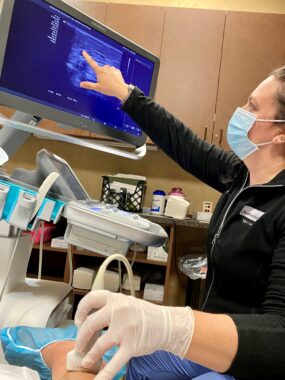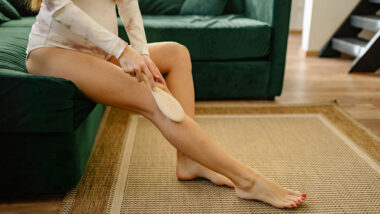If you’ve noticed small red, blue or purple lines appearing on your legs as you age, you’re not alone. Around 50% of women experience spider veins on their bodies as they get older, and up to 80% may have spider veins or thicker varicose veins by age 80. While spider vein causes vary, and they may not cause physical symptoms, the visible lines can make some women and men feel insecure about their appearance. Spider veins may also be a sign of underlying vein disease, which can cause more severe clinical symptoms over time. For cosmetic and clinical reasons, many patients seek treatment for spider veins to improve confidence and comfort with age.
Spider Veins Causes and Symptoms
Spider veins, also called thread veins or telangiectasias, are small, damaged blood vessels close to the surface of your skin, causing visible lines on your skin. While most spider veins appear on the legs, they can happen on other parts of the body, such as your face. Spider veins are not the same thing as varicose veins, which are larger. Varicose veins may bulge out from the skin or appear ropelike.
Spider veins are caused when our veins weaken. Valves in the veins typically push blood flow back to the heart, but if they are damaged, more blood stays in the veins. This damage puts pressure on the walls of the veins, causing them to swell. Risk factors for developing spider veins include:
- Aging
- Being overweight
- Being pregnant
- Certain medical conditions that damage your veins, such as blood clots
- Family history of spider veins or varicose veins
- Sitting or standing for long periods
- Using hormonal birth control
Although spider veins are more common as we get older, they can happen at any age. Often the discoloration of your skin is the only sign of spider veins. But some patients will experience symptoms such as:
- Cramping
- Itching
- Tired or achy legs after standing or sitting for a long time
Diagnosing Spider Veins
Talk to your doctor about your spider veins and any symptoms you’re experiencing. They could indicate a problem with your vein health, such as chronic venous insufficiency (CVI). If you have CVI, you are not only at risk for developing larger varicose veins, but you could also develop eczema, skin discoloration, and sores or ulcers on your legs.
To evaluate your spider veins, your provider may order an ultrasound to get a clearer picture of what is happening in your veins. At Charlotte Radiology’s Vein Centers, our vein specialists map your veins through ultrasound imaging as part of an initial consultation. This visit also includes a clinical explanation of findings and discussion of your vein health and a customized treatment plan with a physician specialized in vein and vascular diagnoses and treatments. You will leave the consultation with a detailed personal treatment plan and timeline so you can determine next steps.
Read More: This Is Why I Chose Charlotte Radiology for Vein Treatment
Treatment for Spider Veins
Spider veins will not go away on their own, but you can take steps to prevent more spider veins in the legs from developing. Your doctor may recommend that you wear compression stockings, avoid hot baths, get plenty of exercise, and be mindful of how long you are sitting and standing.
Charlotte Radiology Vein Centers offer two leading-edge nonsurgical procedures that can treat them.
- This procedure is the most common treatment for spider veins. Providers inject a chemical into your affected vein. This chemical causes the vein walls to stick together and close, rerouting the blood flow elsewhere. You will need to wear compression stockings for two to three weeks following this procedure.
- Endovenous laser therapy (EVLT). If you are found to have underlying venous insufficiency, you can benefit from having EVLT to close the larger refluxing leg veins that are causing your spider veins to form. During EVLT, a provider inserts a small laser fiber into the affected vein. When the laser heats up, it closes off the damaged vein. The treatment does not damage surrounding blood vessels and tissue. These quick laser treatments mean that you can return to normal activity within a day, although you will need to wear compression stockings for a week or two. After completing EVLT treatment, sclerotherapy to your spider veins will produce a longer lasting result. Otherwise, you will be prone to developing recurrent spider veins.
These minimally invasive procedures will have you back to your regular routine in no time, ready to bare your legs, free of unsightly spider veins.



